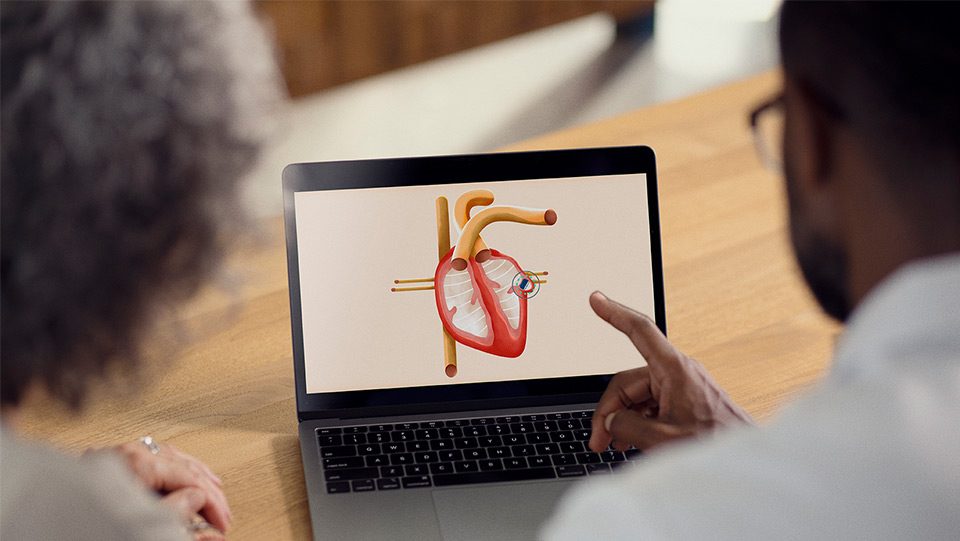WATCHMAN Education Specialists are trained professionals with healthcare experience. They're here to help answer your questions.
Already took the quiz? Return to your personalized experience.
Leave blood thinners behind
AFib doesn't have to mean a lifetime of risk and worry about the side effects of blood thinners. For people who need an alternative, there’s the WATCHMAN Implant. The WATCHMAN Implant is a safe, minimally invasive, one-time implant for people with non-valvular atrial fibrillation (AFib) that reduces your stroke risk – without the need for lifelong blood thinners. In a clinical trial, 96% of people were able to stop their blood thinners 45 days after getting the WATCHMAN Implant.1
There are risks associated with all medical procedures. Please talk with your doctor about the risks and benefits of the WATCHMAN Implant.

The WATCHMAN Implant device reduces the risk of stroke from non‑valvular AFib
Blood thinners aren't the only option to reduce AFib stroke risk. The WATCHMAN Implant is the most implanted FDA-approved device proven to reduce stroke risk in people with atrial fibrillation not caused by a heart valve problem. Watch the video to learn more and talk to your doctor about the WATCHMAN Implant.
Over 600,000 people have left blood thinners behind with the WATCHMAN Implant
Real people who chose the WATCHMAN Implant
Meet people living free from worrying about stroke risk and serious bleeding events – thanks to the WATCHMAN Implant.
DANIEL TALKS WITH DR. FLOOD
“WATCHMAN is about restoring lives.”
When Dr. Flood realized Daniel was less active and less happy on blood thinners, he recommended the WATCHMAN Implant.
MEET CAROLE
“I’m so much more relaxed about enjoying things I want to do.”
Since receiving the WATCHMAN Implant, Carole enjoys traveling without fear of bleeding.
Keep exploring
“We are people living with AFib.”
An introduction to the population of 600,000+ people who've left blood thinners behind and said goodbye to their bleeding worry – for life.
Have questions about the WATCHMAN Implant?
Monday to Friday, 8 a.m. to 5 p.m. CT
*In a clinical trial, 96% of patients were able to discontinue their blood thinner 45 days after getting the WATCHMAN Implant.
References:
1. Kar, S., et al, Primary Outcome Evaluation of the Next Generation LAAC Device: Results from the PINNACLE FLX Trial, Circulation, 2021.
All images are the property of Boston Scientific. All trademarks are the property of their respective owners.
Content on this web page is for Informational Purposes only and does not constitute medical advice and should not be used for medical diagnoses. Boston Scientific strongly recommends that you consult with your physician on all matters pertaining to your health or to address any clinical/medical questions.
Important Safety Information
The WATCHMAN FLX and WATCHMAN FLX Pro Devices are permanent implants designed to close the left atrial appendage in the heart in an effort to reduce the risk of stroke.
With all medical procedures there are risks associated with the implant procedure and the use of the device. The risks include, but are not limited to, accidental puncture of the heart causing fluid to collect around the heart possibly leading towards the need for an additional procedure, allergic reaction, anesthesia risks, altered mental status or confusion after procedure, arrhythmias (irregular heartbeats), bleeding or throat pain from the TEE (Trans Esophageal Echo) probe, chest pain/discomfort, congestive heart failure, renal failure, excessive bleeding, gastrointestinal bleeding, groin puncture bleed, bruising at the catheter insertion site, groin pain, anemia (reduced red blood cells requiring transfusion), hypotension, infection/pneumonia (example: in or around your heart or lungs), misplacement of the device, improper seal of the appendage or movement of device from appendage wall, clot formation on the device, blood clot or air bubbles in the lungs or other organs, stroke, transient ischemic attack (temporary stroke-like symptoms), cranial bleed (bleeding in or around your brain), thrombosis (blockage of a blood vessel or vein by a clot) and in rare cases death can occur.
Be sure to talk with your doctor so that you thoroughly understand all of the risks and benefits associated with the implantation of the device. SH-2109508-AA



